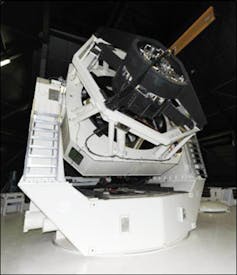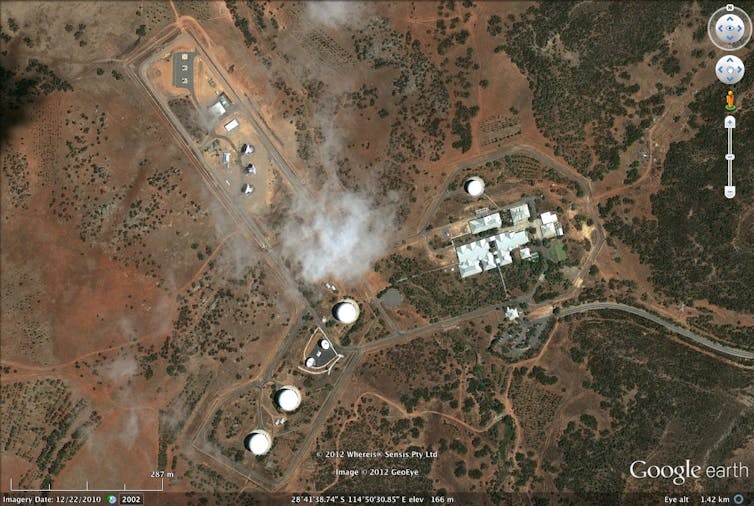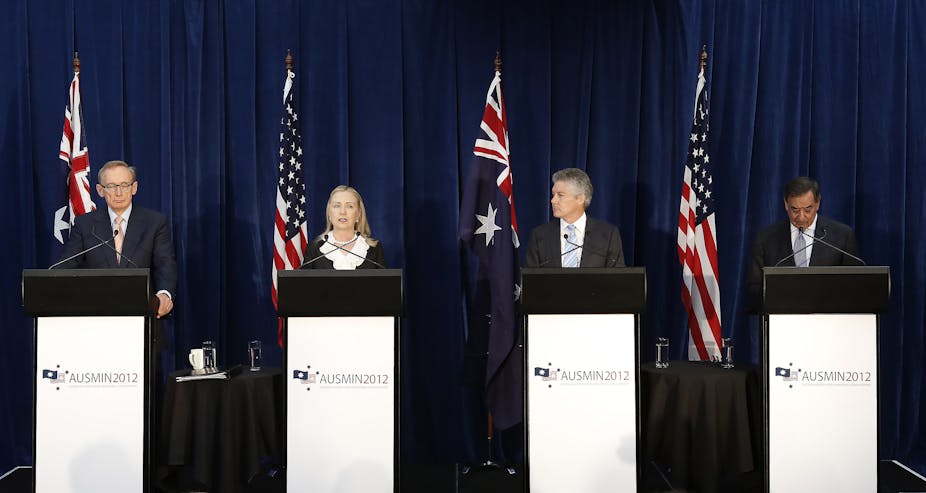Foreign minister Bob Carr told the Australian yesterday that his top two priorities are to ensure the US is engaged in our region, and to handle Australia’s relationship with Asia better.
But the “joint facilities” announced last month at AUSMIN, the annual ministerial meeting between the two nations’ governments could endanger those priorities. This brings an unprecedented level of Australian support for American military systems, expands US technological integration of Australian defence forces, and increases the number, size and sophistication of US military facilities in Australia.
The announcement was recognised by the American press as “the latest sign of US pivot toward Asia”. There are three key US facilities that signal this pivot: a space radar for North West Cape; a state of art US deep space telescope that tracks micro satellites; and a new “combined communications gateway” providing Australia access to US satellites.
North West Cape space radar
Building on AUSMIN 2010, a new agreement was signed in Perth as “a demonstration of our commitment to closer space cooperation”. This authorised the transfer of a US space radar from Antigua to the Harold E. Holt Naval Communication Station at North West Cape.
The mechanical radar was used at Antigua for tracking US launches from Cape Canaveral. In Australia, under the auspices of the US Joint Space Operations Center, a collaborative operation will include tracking satellites in low earth orbit, missile launches from neighbouring countries, and, as a public good, space junk.
The Pentagon, facing a budget crunch, is still to decide whether a more advanced radar similar to the one in the Pacific island of Kwajalein will be deployed in Western Australia or in the British Atlantic island of Ascension.
DARPA telescope to track Chinese satellites

US radars can detect objects in geo-synchronous orbits (GEO) but searching in GEO is “time-consuming and difficult”, while telescopes can do so much more readily. At AUSMIN, the two countries decided to “work towards” re-deployment of a Space Surveillance Telescope from New Mexico to Australia.
The Defense Advanced Research Projects Agency took more than ten years to build this telescope, which only achieved first light in October 2011. According to Pentagon officials, the telescope will improve the search rate and tracking of satellites. There are now a large number of Chinese military intelligence, communications, and global positioning satellites in GEO. The Pentagon said “the Australians are in the process of selecting a site for the SST.”
The Geraldton communications gateway
AUSMIN 2008 formalised an integration of US and Australian military communications systems. The Perth meeting announced a “Combined Communications Gateway” in Western Australia to “provide both Australia and the United States greater access to the Wideband Global Satellite communications constellation”.
This year’s AUSMIN announcement of a Combined Communications Gateway will provide “a dual nation access point” to the Wideband Global Satellite (WGS) facility at the Australian Defence Satellite Communications Station at Kojarena near Geraldton.
In US military talk, “communications gateway” refers to the network of hardware, software and interface protocols that link communications systems effectively. For the United States, this is a growing problem in the technology of networked warfare with and between its alliance partners – such as NATO member countries, or, in a more exclusive club, the “Five-Eyes”. One aspect of a communications gateway is to preserve security concerns about hierarchical access to information, not all are trusted with same levels of access.

Recognising Australian national interests
Malcolm Fraser and Paul Keating have questioned the inability of Australian governments to recognise the points at which Australia’s national interests diverge from those of its major ally. Bob Carr has said he doesn’t have to respond to such allegations.
But in this political climate, national interests are certainly not the end of the discussion. Human interest and global responsibility need to be taken into account. And without the capacity to recognise and act in the national interest, a country with a parliamentary democracy operates under a severe democratic deficit.
We are at a dangerous time strategically. If anything, Fraser and Keating have understated those dangers, both in range and severity. As Kevin Rudd said recently, talk of war between China and the US is almost unbelievable.
But some influential people, such as US academic John Mearsheimer, are saying just that. The danger lies in the combination of enthusiastic and uncritical Australian government support for US hawks on China, together with the integration of Australian and US military systems in “joint facilities”.
Australians need to ask the federal government simple but serious questions about the implications of these space facilities and pursue answers beyond spin and contempt for the public to be able to decide on its own view.
The fundamental issues are whether an Australian government retains its sovereign power to ensure that the “joint facilities” are not used against our own interests, or that the integration of Australia with US forces does not render independent choice by Australia impossible.
Without that capacity, the formation of democratic policy about defence becomes a contradiction and a dangerous impossibility.
A longer version of this article can be found at the Nautilus Institute Policy Forum.

